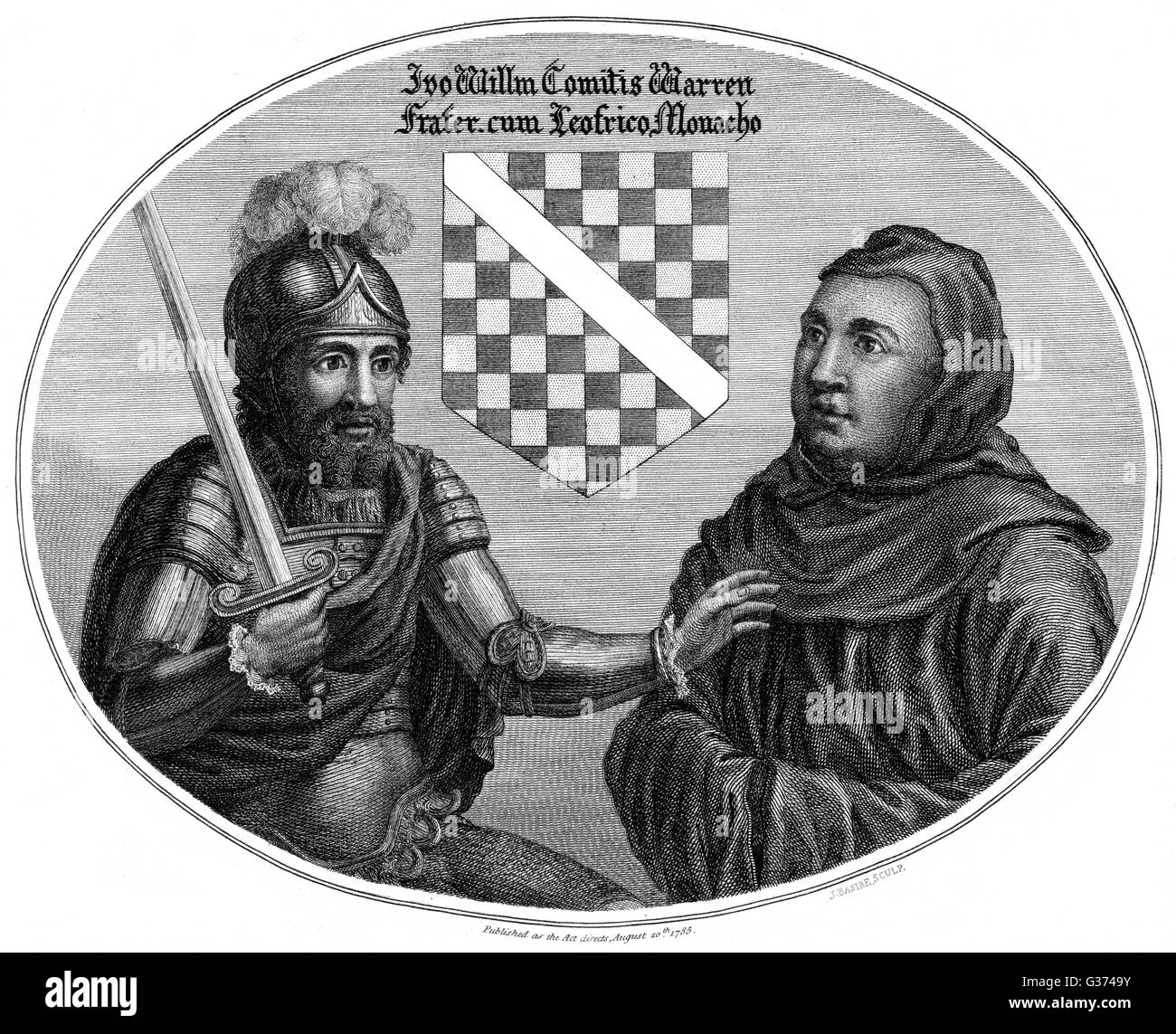Image details File size:
84.6 MB (6.1 MB Compressed download)
Open your image file to the full size using image processing software.
Dimensions:
6042 x 4895 px | 51.2 x 41.4 cm | 20.1 x 16.3 inches | 300dpi
Date taken:
3 February 2014
More information:
This image could have imperfections as it’s either historical or reportage.
Search stock photos by tags
Similar stock images JOHN WILLIAM earl of WARENNE and his brother LEOFRIC, a monk Date: ? - 1240 Stock Photo https://www.alamy.com/image-license-details/?v=1 https://www.alamy.com/john-william-earl-of-warenne-and-his-brother-leofric-a-monk-date-1240-image557102225.html RM 2RAA5G1 – JOHN WILLIAM earl of WARENNE and his brother LEOFRIC, a monk Date: ? - 1240 JOHN WILLIAM earl of WARENNE and his brother LEOFRIC, a monk Stock Photo https://www.alamy.com/image-license-details/?v=1 https://www.alamy.com/john-william-earl-of-warenne-and-his-brother-leofric-a-monk-image560862651.html RM 2RGDE0Y – JOHN WILLIAM earl of WARENNE and his brother LEOFRIC, a monk Conisborough Castle is a medieval fortification in Conisborough, South Yorkshire, England. The castle was initially built in the 11th century by William de Warenne, the Earl of Surrey, after the Norman conquest of England in 1066. It was used by Sir Walter Scott as the location for his 1819 novel Ivanhoe. Stock Photo https://www.alamy.com/image-license-details/?v=1 https://www.alamy.com/stock-image-conisborough-castle-is-a-medieval-fortification-in-conisborough-south-168327738.html RM KNRYMX – Conisborough Castle is a medieval fortification in Conisborough, South Yorkshire, England. The castle was initially built in the 11th century by William de Warenne, the Earl of Surrey, after the Norman conquest of England in 1066. It was used by Sir Walter Scott as the location for his 1819 novel Ivanhoe. John de Warenne, 6th Earl of Surrey, 1231 - 1304 , justifying the titles to his estates. In 1278 King Edward I, in an attempt to reclaim what he considered Royal Lands issued de Warenne, and others, a writ of quo warranto, or 'by what warrant', that is, by what right did he hold his lands. De Warenne is said to have responded by drawing an ancient family sword and declaring that the sword had belonged to his ancestors who had come to England with William the Conqueror, that they had conquered his lands with that sword and that he would defend his lands against anyone who tried to take them f Stock Photo https://www.alamy.com/image-license-details/?v=1 https://www.alamy.com/john-de-warenne-6th-earl-of-surrey-1231-1304-justifying-the-titles-to-his-estates-in-1278-king-edward-i-in-an-attempt-to-reclaim-what-he-considered-royal-lands-issued-de-warenne-and-others-a-writ-of-quo-warranto-or-by-what-warrant-that-is-by-what-right-did-he-hold-his-lands-de-warenne-is-said-to-have-responded-by-drawing-an-ancient-family-sword-and-declaring-that-the-sword-had-belonged-to-his-ancestors-who-had-come-to-england-with-william-the-conqueror-that-they-had-conquered-his-lands-with-that-sword-and-that-he-would-defend-his-lands-against-anyone-who-tried-to-take-them-f-image532538789.html RM 2NXB6JD – John de Warenne, 6th Earl of Surrey, 1231 - 1304 , justifying the titles to his estates. In 1278 King Edward I, in an attempt to reclaim what he considered Royal Lands issued de Warenne, and others, a writ of quo warranto, or 'by what warrant', that is, by what right did he hold his lands. De Warenne is said to have responded by drawing an ancient family sword and declaring that the sword had belonged to his ancestors who had come to England with William the Conqueror, that they had conquered his lands with that sword and that he would defend his lands against anyone who tried to take them f Shepherd and flock near Lewes Priory, founded by William de Warenne, 1st Earl of Surrey and his wife Gundrada, probably in 1081, is a demolished medieval Cluniac priory in Southover, East Sussex in the United Kingdom Stock Photo https://www.alamy.com/image-license-details/?v=1 https://www.alamy.com/stock-photo-shepherd-and-flock-near-lewes-priory-founded-by-william-de-warenne-172846835.html RM M15RW7 – Shepherd and flock near Lewes Priory, founded by William de Warenne, 1st Earl of Surrey and his wife Gundrada, probably in 1081, is a demolished medieval Cluniac priory in Southover, East Sussex in the United Kingdom Battle of Stirling Bridge 1297 19th Century Illustration Stock Photo https://www.alamy.com/image-license-details/?v=1 https://www.alamy.com/stock-photo-battle-of-stirling-bridge-1297-19th-century-illustration-21831201.html RM B7EDWN – Battle of Stirling Bridge 1297 19th Century Illustration 1870: Stirling Bridges built in the 15th or 16th Century, replaced a succession of timber bridges is the site of a battle during the First War of Scottish Independence. On 11 September 1297, the forces of Andrew Moray and William Wallace defeated the combined English forces of John de Warenne, 6th Earl of Surrey, and Hugh de Cressingham near Stirling, on the River Forth, Stirling, Scotland Stock Photo https://www.alamy.com/image-license-details/?v=1 https://www.alamy.com/1870-stirling-bridges-built-in-the-15th-or-16th-century-replaced-a-image156833808.html RM K34B3C – 1870: Stirling Bridges built in the 15th or 16th Century, replaced a succession of timber bridges is the site of a battle during the First War of Scottish Independence. On 11 September 1297, the forces of Andrew Moray and William Wallace defeated the combined English forces of John de Warenne, 6th Earl of Surrey, and Hugh de Cressingham near Stirling, on the River Forth, Stirling, Scotland The Battle of Stirling Bridge The Battle of Stirling Bridge was a battle of the First War of Scottish Independence. On 11 September 1297, the forces of Andrew Moray and William Wallace defeated the combined English forces of John de Warenne, 6th Earl of Surrey, and Hugh de Cressingham near Stirling, on the River Forth. Image sourced from Cassell's Illustrated Universal History (1893). Stock Photo https://www.alamy.com/image-license-details/?v=1 https://www.alamy.com/stock-photo-the-battle-of-stirling-bridge-the-battle-of-stirling-bridge-was-a-118707213.html RM GW3G79 – The Battle of Stirling Bridge The Battle of Stirling Bridge was a battle of the First War of Scottish Independence. On 11 September 1297, the forces of Andrew Moray and William Wallace defeated the combined English forces of John de Warenne, 6th Earl of Surrey, and Hugh de Cressingham near Stirling, on the River Forth. Image sourced from Cassell's Illustrated Universal History (1893). Conisbrough Castle, Conisbrough, South Yorkshire, England Stock Photo https://www.alamy.com/image-license-details/?v=1 https://www.alamy.com/conisbrough-castle-conisbrough-south-yorkshire-england-image218821337.html RF PM04RN – Conisbrough Castle, Conisbrough, South Yorkshire, England The remains of the former Norman castle at Caste Acre, north-west Norfolk, England Stock Photo https://www.alamy.com/image-license-details/?v=1 https://www.alamy.com/stock-photo-the-remains-of-the-former-norman-castle-at-caste-acre-north-west-norfolk-27850972.html RM BH8M5G – The remains of the former Norman castle at Caste Acre, north-west Norfolk, England Castle Acre Priory, 1537, (c1990-2010). Artist: Ivan Lapper. Stock Photo https://www.alamy.com/image-license-details/?v=1 https://www.alamy.com/stock-photo-castle-acre-priory-1537-c1990-2010-artist-ivan-lapper-135305614.html RM HT3KKA – Castle Acre Priory, 1537, (c1990-2010). Artist: Ivan Lapper. The keep of Lewes Castle, East Sussex, UK Stock Photo https://www.alamy.com/image-license-details/?v=1 https://www.alamy.com/the-keep-of-lewes-castle-east-sussex-uk-image360646475.html RF 2BXMT77 – The keep of Lewes Castle, East Sussex, UK 